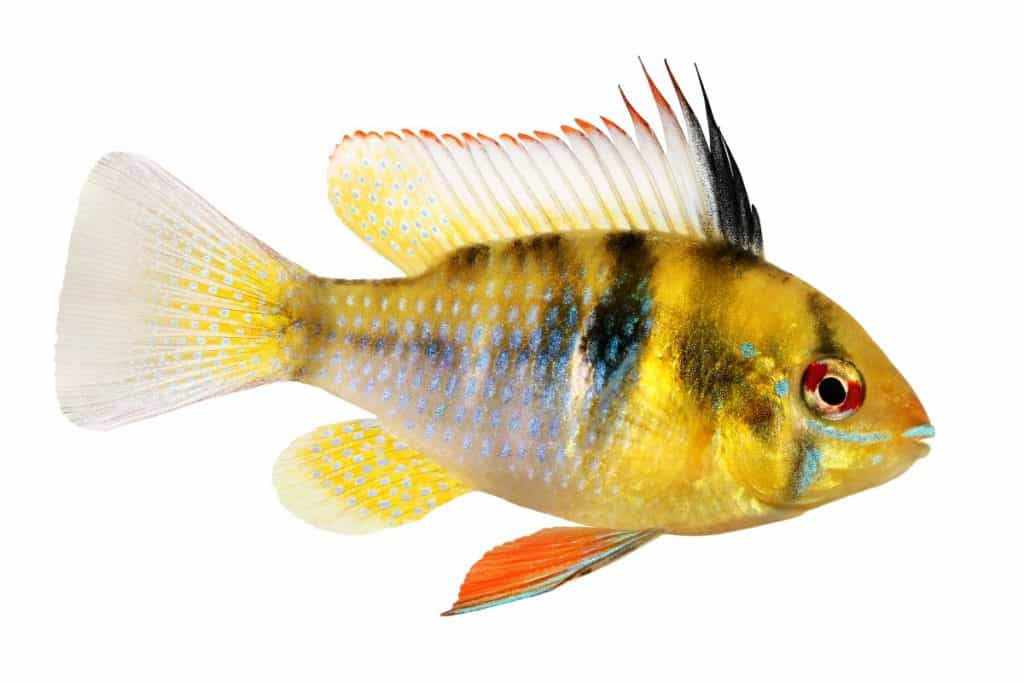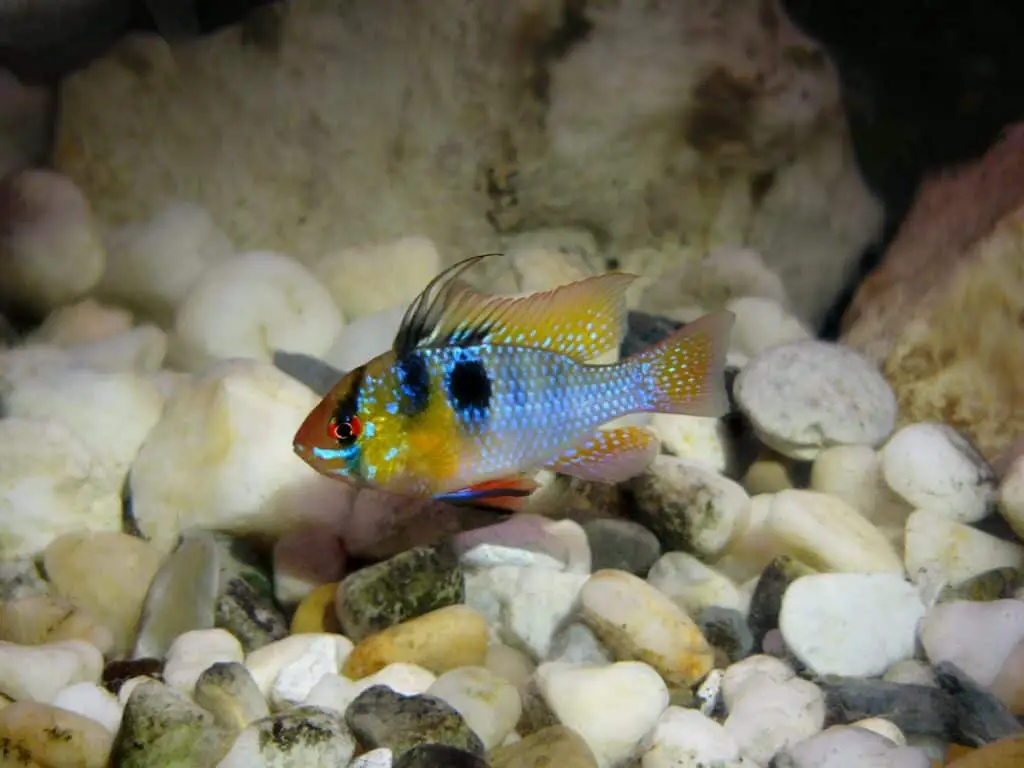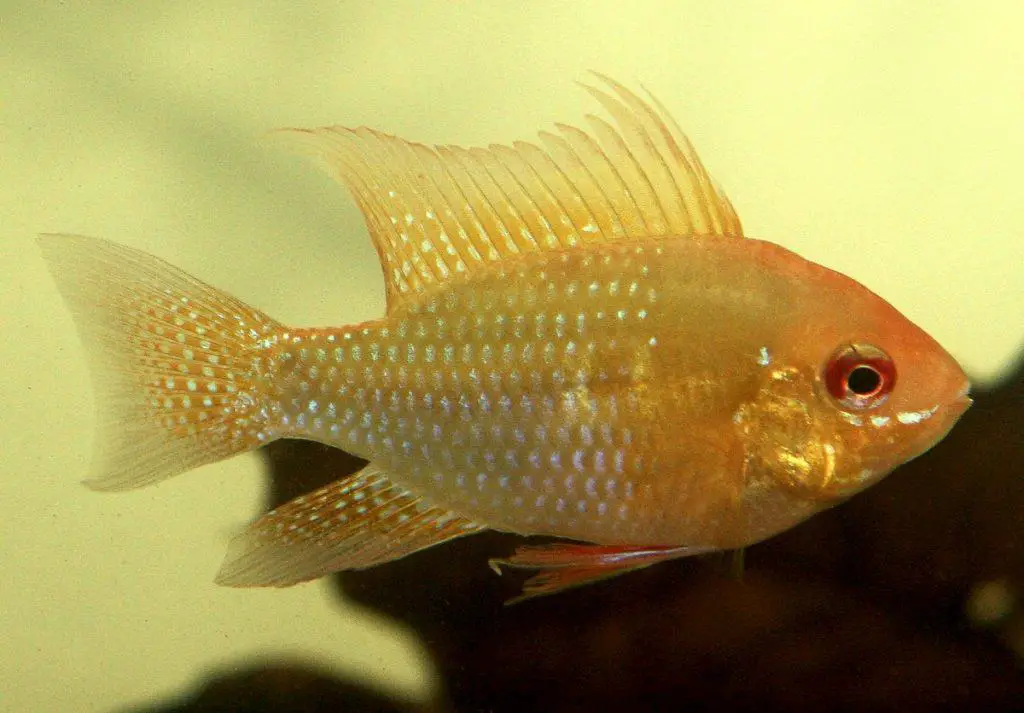The Ram Cichlid is a popular aquarium species that has been developed and bred to include numerous different strains. These strains are sold under many different names including Ram, Blue Ram, Asian Ram, Butterfly Cichlid, Ramirez’s Dwarf Cichlid, Butterfly Cichlid, and Ramizeri.
Despite the plethora of names for this fish species, there are only really four different types. These are the Bolivian Ram, Electric Blue Ram, German Blue Ram, and Golden Ram. The latter three are sometimes available in a long finned or balloon strain but still fall under the same categories.
How many types of ram cichlid are there? There are numerous strains of M.

Table of Contents
How Many Types of Ram Cichlid are there?
Also known as the Butterfly or Red Ram, the Bolivian Ram is one of the two Ram Cichlids that is found in a natural habitat. They come from South American countries such as Bolivia and Brazil. Here they are found within densely planted areas where they sift for food in the peaty substrate.
Probably the plainest of the Ram Cichlids, the Bolivian has a golden brown body with reddish highlights on the caudal and dorsal fins. There also may be pearly turquoise highlights on the pelvic and anal fins.
A black stripe runs down the face straight through the eye, and also the front of the dorsal fin. They are the largest of the Ram Cichlids at around 3 inches.
Many different strains exist which have been breed within the industry and different variations of each fish. All come from the Cichlidae Family and the original Mikrogeophagus
Below are some of the most common and most beautiful types of Ram Cichlids.
The Electric Blue Ram

Of all the Ram Cichlids the Electric Blue has undeniably the fiercest appearance. This is probably due to its striking red eyes against a sparkling electric blue coloration. The dorsal fins on this Ram Cichlid are spiked and they have a low slung pectoral fin. They are smaller than the Bolivian Ram at around 2.5 inches. If you’d like to know more about the sizes of all the Ram Cichlid Types, Click Here!
Despite looking fierce, the Electric Blue Ram has a prize-winning personality. They are social and peaceful, making them an ideal community aquarium inhabitant. They are best kept in pairs, in which they are usually faithful.
The German Blue Ram

The German Blue Ram is undoubtedly the most popular of the Ram Cichlids available. Like the Electric Blue, they are bred in captivity and slightly smaller than the Bolivian at 2.5 inches. They also have a very personable personality and make excellent community aquarium members.
The main body of a German Blue Ram is split between orange to gold and turquoise blue. They have a black stripe down their face which crosses their bright orange eyes. Blue mottling can be found upon their fins, and a black dot is prominent on their midriff.
The Golden Ram

The Golden Ram is the second of the two Ram Cichlids found in a natural habitat, and not just captive bred. They make their home in the Rio Orinoco drainage within Venezuela and Colombia where they will be found in pairs.
Appearance wise, the approximately 2.5 inch Golden Ram has a light golden body coloration with electric blue mottling on its fins. The dorsal fin, like the Electric Blue Ram, is spiky, and the eye is pale with a large black pupil. They are definitely the lesser known Ram Cichlid of the four.
Ram Cichlid Commonalities
Whilst the Ram Cichlids may look very different they all have the same basic personalities and care requirements. All Ram Cichlids are extremely sociable, friendly, and go well in community aquariums.
They do, however, need to be kept with other species that are not overly active or aggressive. This is mainly due to the Ram Cichlids inability to compete well for food.
Aquarium wise a minimum size of 30 gallons is required for a pair of any of the four Ram Cichlid species. Lighting should be subdued if you want to see them out and about swimming.
Ram Cichlids also like fine substrates that they can sift for food within and densely planted areas and caves for them to hide in. Water parameters should be in the 72-82℉ temperature range with pH being between 5.2-6.7.

Do All Types Of Ram Cichlids Eat The Same Foods?
Ram Cichlids are omnivores that will eat most anything they are offered. They should be given a diet of both meaty and green foods to keep them in optimum health. A good diet would include high-quality flake or pellet, fresh or frozen brine shrimp, bloodworm, and chopped earthworms.
We feed our Rams two types of staple foods. the first is Omega Cichlid Flakes which we feed a small portion 3 times a day and the second is Omega small cichlid pellets. We find these 1mm size pellets are perfect for all types of ram cichlids.
It should be noted that some Ram Cichlids may take some time to start eating on introduction to an aquarium. If this is the case offering foods such as mosquito larvae should coax them to eat.
If you’re still unsure what to feed your Ram Cichlid then take a look at our Ram Cichlid feeding Guide.
Do All Species Of Ram Cichlids Breed The Same Way?
Breeding wise Ram Cichlids are egg layers with both parents taking care of the offspring. They are not mouthbrooders but have been known to mouth brood if they believe their young are in danger.
Juveniles are generally found in groups together, probably for safety in numbers, but as adults dwindle down to pairs.
Conclusion: Types of Ram Cichlids
The truth is, it doesn’t really matter which of the Ram Cichlid types you pick as you will be getting a fabulous fish with all of them.
You may find our Complete Ram Cichlid Care Guide helpful. Packed with all the information that you’ll need to purchase and care for a Ram Cichlid.
They are incredibly attractive, with lovely personalities, and pretty easy to please. A fishkeepers dream, I hear you say, and you’d be exactly right!
[author title=”About the Author”]

I have been working in the tropical fish industry for over 30 years now and I’m still learning. Everyday is a school day in this hobby. In my spare time I play golf very badly!


